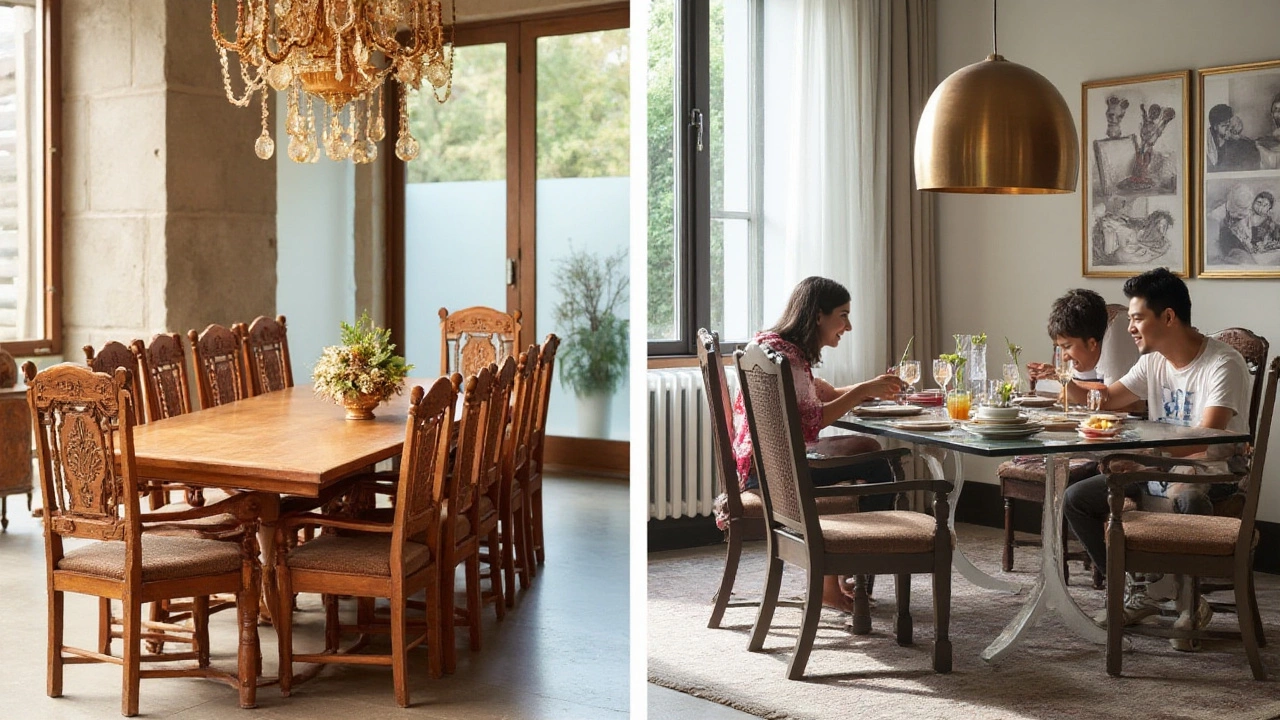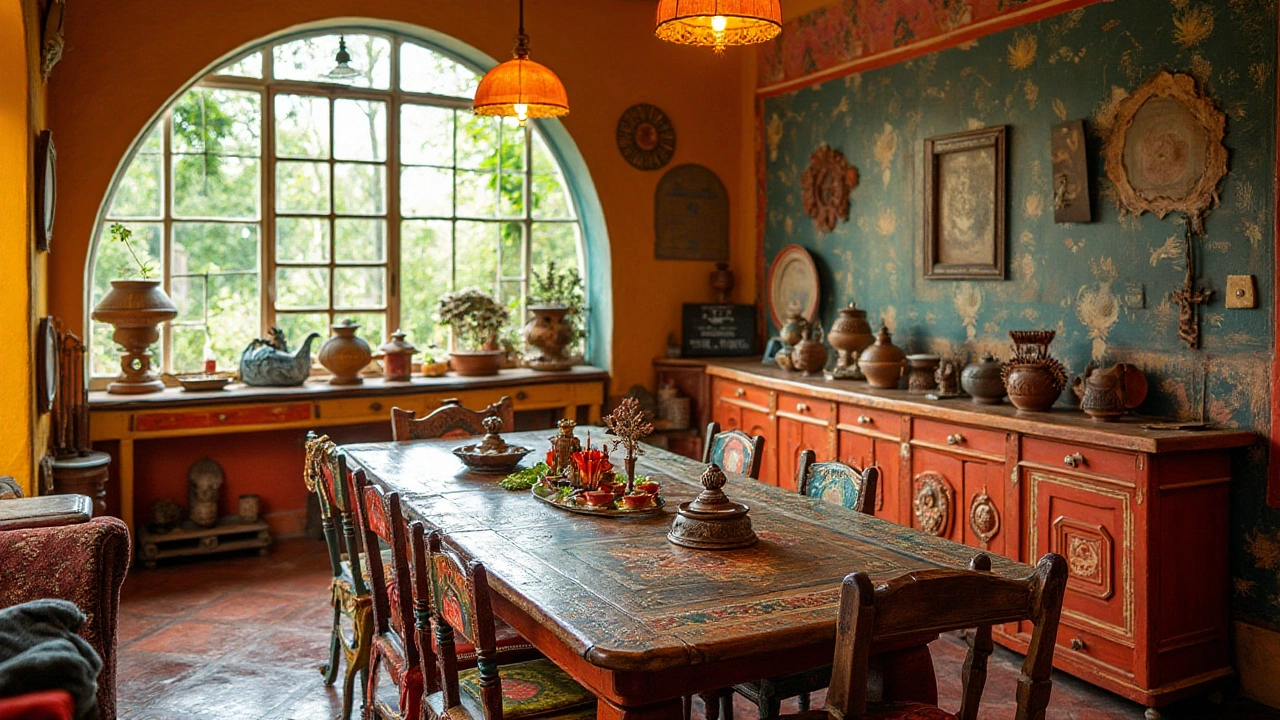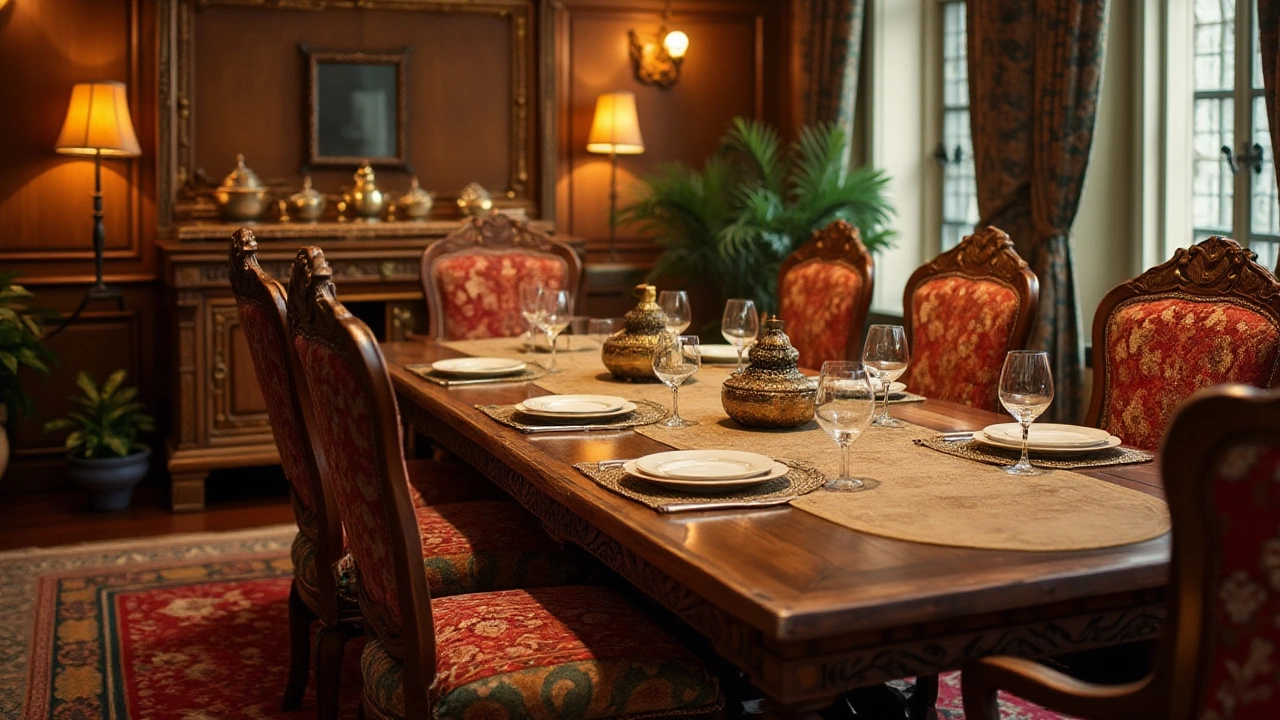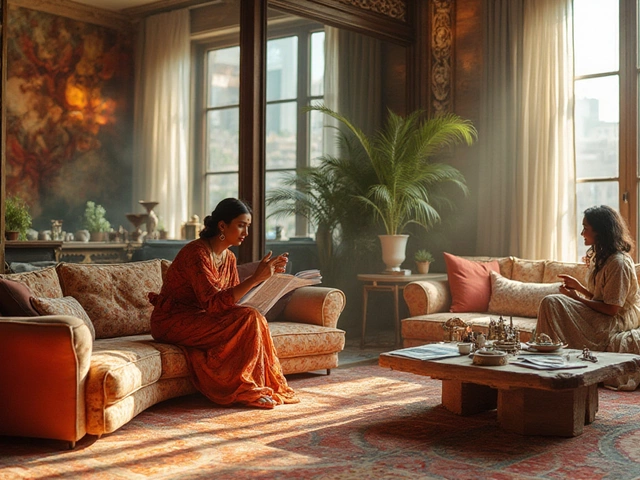The dining room is more than just a place to enjoy meals; it acts as the beating heart of home gatherings and celebrations. The furniture within this space not only defines the room’s style but also its functionality and comfort. From the iconic dining table to more subtle additions like a sideboard or buffet, each piece carries its own story and purpose.
Understanding the varied furniture names and their uses helps in tailoring your dining room to match both your aesthetic preferences and practical needs. Whether you are embarking on creating a new dining area or simply wanting to refresh your existing space, knowing what to call each piece will empower you with the design language needed to transform your home.
- The Heart of the Dining Room: The Dining Table
- Keeping it Cozy: Chairs and Seating Options
- Buffet or Sideboard: Storage and Style
- Adding Ambiance: Lighting and Accessories
- Unique Pieces: Breaking the Norm
- Choosing the Right Fit for Your Space
The Heart of the Dining Room: The Dining Table
The dining table often holds the title of the centerpiece of the dining room, a symbol of togetherness and festivity. Its origins date back to ancient times when makeshift communal tables were used in large halls for feasts. Fast forward to today's modern homes, the dining table not only serves a practical purpose but also embodies style and individual taste. Typically made from wood, glass, or metal, the design possibilities are endless, ranging from minimalist Scandinavian styles to ornate Victorian pieces. It anchors the space, serving as a focal point where the family gathers, friends reunite, and memories are made around shared meals.
The versatility of the dining table is remarkable. Beyond its primary function of hosting meals, it can transform into a workspace, a crafting table, or even a makeshift stage for kids' performances. Choosing the right dining table requires consideration not only of size and shape but also of materials and adaptability to different occasions. Round tables foster intimacy and conversation, ideal for smaller families or dining areas, while rectangular or oval tables can accommodate larger gatherings. Notably, the table you choose can be a testament to both tradition and innovation. Reinventing materials such as reclaimed wood or innovative eco-friendly surfaces supports sustainability and brings a unique character to the room.
Dimensions are critically important when selecting a dining table. A table too large can overwhelm the room, while a table too small can feel lost and impractical. Most tables are about 30 inches tall, providing standard comfort, but considerations like apron height and leg room can impact usability for taller guests or those in wheelchairs. The space each person requires is also essential—typically 24 inches of width per person ensures comfort, especially during celebratory feasts where table space can rapidly become occupied by delightful spreads.
"A dining room table reflects who you are, your lifestyle, and the experiences you want to create at home," says renowned interior designer Nate Berkus, articulating the profound role that this piece of furniture plays in personal and social design.In some cultures, the dining table is deeply symbolic, representing unity and abundance. Feng Shui principles advise placing the dining table in a balanced and central location to promote harmony and well-being. Similarly, table decor such as seasonal tablecloths, a rotating centerpiece, or a luxurious chandelier can reinforce the ambiance, making the ordinary family dinner feel a touch more special. Its role, both functional and aesthetic, underscores how indispensable the dining table is to a space dubbed the heart of the home.
Keeping it Cozy: Chairs and Seating Options
In the realm of dining room furniture, choosing the right chairs and seating options carries an essence that extends beyond mere aesthetics. The perfect chair harmonizes comfort and style, creating an inviting space where loved ones gather. Chairs need to blend with the dining table in scale and style, but they also stand as individuals, demanding their own consideration. Let’s explore a variety of seating options that not only enhance the dining experience but also complement your room’s design narrative.
The most traditional option, of course, remains the classic dining chair. Crafted from wood, metal, or even acrylic, these chairs offer a spectrum of styles from ornate Victorian to minimalist contemporary designs. It's interesting to note that the first sets of dining chairs were reserved for the head of the table—literally seats of power. As styles evolved over the centuries, the diversity of materials expanded, reflecting changes in technology and taste. Yet, comfort has always remained at the forefront. Features like padded seats or upholstered backs often sway the decision-making process, as they can make a lengthy dinner both enjoyable and leisurely.
"The dining room is a place to linger," suggests interior designer Justine Kalaz. "Comfortable seating is not just about physical ease but about making guests feel at home."Beyond the traditional chair, benches present a communal feel and bring versatility to your dining setup. These are especially popular in open-plan spaces where delineation between rooms is subtle. A bench can easily segue into extra seating for a living area or become an aesthetic prop adorned with custom cushions and throws. They're perfect for families with children, offering flexibility and more seating space without requiring as many individual chairs.
Another dynamic option is the inclusion of high-backed chairs at the heads of the table, flanked by lower-profile seats along the sides. This arrangement mixes visual interest without overwhelming or disrupting the room's balance. High-backed chairs often come with intricate designs and can be a focal point that bookends a striking table. A smooth blend of these styles within your dining area can communicate both elegance and cosiness.
Comfort doesn’t just come from structure but also in spatial arrangement. There's a delightful science in ensuring there’s enough room for guests to pull out chairs, sit comfortably, and have meaningful conversations without feeling cramped. Ideally, there should be about 24 inches allotted per chair for seated guests to accommodate arm movements and ease of entry. Additionally, the chair seat height should align with the table's height, usually leaving about 12 inches from the tabletop to the seat.
For those seeking opulence, upholstered chairs can elevate the dining experience by adding tactile luxury. Imagine being enveloped in soft velvet or snug leather as you savour a multi-course meal. Such materials not only offer enhanced comfort but introduce texture and depth to an otherwise neutral palette. But practicality shouldn’t be overlooked. Always consider materials that align with usage and ease of cleaning, particularly in homes with children or frequent entertaining.
So, when envisioning seating options for your dining room, think of how chairs and benches will engage with the entirety of your interior space. Every choice should reflect a piece of your personality while welcoming guests into a space of warmth and ease. And remember, the best seat in the house is often the one you share with good company and conversation.

Buffet or Sideboard: Storage and Style
The dining room often features a piece of furniture that is both decorative and functional: the sideboard or buffet. Originally designed as surface space for laying out dishes, these furnishings have evolved significantly over the years. Today, they are not only about utility but also about making a style statement in your dining room furniture collection. Sideboards typically have a series of cabinets, drawers, and sometimes shelving, making them ideal for storing dinnerware, table linens, and other dining essentials that may not be in everyday use. Their slightly elevated height compared to a dresser allows them to display art pieces, plants, or beloved family photographs, enhancing the room’s aesthetic while serving functional needs.
Interestingly, buffets and sideboards are often terms used interchangeably, though there was a time when each had its own distinct purpose. Historically, the buffet was a slightly larger counterpart used primarily in dining rooms, allowing hosts to serve meals or beverages directly from the surface. Over time, the terms have blurred, with the distinction now more in design preference and the space’s function. Many homeowners appreciate the versatility of these pieces, selecting designs that include sleek, modern lines that suit contemporary homes or vintage, rustic looks that add a classic charm to the dining area.
The Evolution from a Serving Tool to Decorative Piece
The journey of the sideboard from a basic piece of storage to a prominent home feature is fascinating. In earlier centuries, its role was to simply hold platters and drinks, but as dining habits have shifted and homes have embraced open floor plans, these pieces have become more integrated into living spaces. Some styles include mirrored panels and intricate carvings, emphasizing luxury and sophistication. In the late 19th century, ornate Victorian sideboards became fashionable, often featuring elaborate carvings and gilded details. These pieces were not just furniture but a symbol of wealth and taste for the household. Today, the sideboard continues to morph with trends, capable of blending into minimalist styles or even taking on quirky, eclectic designs for those who love something unique and statement-making.
Size and materials are often important considerations when adding a buffet or sideboard to your dining setup. With a wide range of options - from walnut to oak and even metal - the choice depends largely on the existing style of your home and the specific needs of your dining area. A sideboard in a small dining room might mean opting for a piece with high functionality and relative compactness, while large, sprawling dining rooms can accommodate grander and more elaborate designs. Some decorators will suggest creating a cohesive look by matching the sideboard’s finish with the dining table, while others encourage using it as a stand-out piece for contrast.
"A well-chosen sideboard not only supports the dining room in function but elevates its style, completing the atmosphere of the space," says interior designer Elle Westwood.Key Considerations for Selecting the Perfect Piece
When it comes to choosing the right buffet or sideboard for your home, consider the daily and occasional uses. Practicality is vital, especially if the dining room regularly entertains guests, requiring ample space for serving dishes or drinks. The dimensions are essential to ensure it fits comfortably without overcrowding. A rule of thumb is to leave at least 36 inches of space on all sides for easy movement. Storage requirements should also weigh in, determining whether more drawers, shelves, or cabinet space is necessary depending on your dining habits. Do not overlook the piece’s style and material—it should complement the existing dining room furniture rather than clash with it.
Finally, placement within the room can impact its user-friendliness and accessibility. Most opt to situate the sideboard along a wall for easy access, though, in larger spaces, it might also serve as a room divider in open-plan settings. Whether traditional or contemporary, the right buffet or sideboard is a valuable addition that marries practicality with style, elevating your dining room's ambiance and keeping it organized.
Adding Ambiance: Lighting and Accessories
When it comes to crafting the perfect dining room setting, lighting and accessories can transform the space from mundane to magical. It's not just about illumination; it's about creating an atmosphere that invites guests to linger over the meal. The right lighting complements the dining table and can drastically change how a room feels, either by highlighting its architectural features or by setting a mood that suits the time of day and the occasion. For instance, pendant lights hung over the dining table can create a focal point that adds a touch of sophistication or warmth, depending on the style you choose. Complementing these with wall sconces or adjustable track lighting can provide flexibility, allowing you to shift the ambiance effortlessly.
Accessories like table runners, centerpieces, and artwork also play a crucial role in dining room decor. By choosing items that reflect your personal style, you can create a space that feels uniquely yours. A vase of fresh flowers or a bowl of fruit can add a splash of color, while a carefully chosen piece of art can serve as a conversation starter during dinner parties. It's these little details that personalize the dining room and make it inviting.
Layered lighting is a technique often recommended by interior designers to add depth and dimension. Start with ambient lighting to provide general illumination. This could come from a chandelier or pendant set strategically over the dining table. Accent lighting, such as small lamps on the buffet or sideboard, should be used to highlight decorative objects and add extra warmth to the room. Finally, task lighting, such as adjustable reading lights, can focus light in specific areas, perfect for more intimate settings or when additional brightness is needed.
Statistics show that well-lit spaces can boost mood and enhance a dining experience. According to a study by the Journal of Environmental Psychology, lighting significantly affects perception, which in turn influences social environments. So it's not just about illumination; a coherent lighting plan can stimulate conversation and create a comfortable dining experience. As for accessories, while tastes are subjective, the key is to begin with a few select pieces and build around them, allowing your personality to shine through in each choice.
Incorporating layers of textiles adds warmth and texture. Consider using a mix of materials, such as linen for a tablecloth with velvet napkins or woven place mats. It's these tactile elements that invite touch, creating an immersive experience. Remember that balance is essential; too many accessories can overcrowd the table, while too few can leave it feeling stark.
"Light has dramatic effects on our dining experiences. It impacts mood and, in doing so, can influence everything from the flavors we taste to the conversations we spark," says renowned interior designer Kelly Hoppen.Make sure to adjust the brightness based on natural light availability, keeping in mind that as daylight fades, warmer light temperatures often create a cozier atmosphere.
Unique Pieces: Breaking the Norm
When it comes to crafting a truly distinctive dining room, sometimes it's the unexpected additions that leave the greatest impression. Breaking away from traditional norms doesn't mean abandoning practicality; rather, it's about adding character through pieces that spark conversation and encapsulate personal style. Unconventional furniture can range from repurposed industrial items to custom-made artisan seats, all designed to elevate a dining space from mere functionality to artistic expression.
Diversifying your dining room furniture could mean embracing materials not typically found in this setting. Think of glass and metal chairs or a marble dining table that serves as both a functional surface and a sculptural element. Such choices, albeit daring, can revolutionize the way the room feels and functions. Imagine a glass-top table with a solid marble base – while it appears sleek and modern, it's rooted in a tradition of luxury and durability.
Dining room furniture as statement pieces often blend artistic aesthetics with pragmatic use. Consider, for instance, the allure of a well-crafted credenza that combines modern design with vintage charm. These items are not merely storage solutions but pieces that tell stories. There's a certain enchantment in finding an old, refurbished item that holds memories and histories, becoming a family centerpiece. Steve Naylor, a noted interior designer, once remarked,
"The pieces we choose to surround ourselves with at the dinner table narrate stories of our life journeys."Function is essential, yet blending in elements that break the monotony of predictability does not compromise comfort. Mixing seating styles can introduce a nonchalant elegance. Swap a few chairs for a tailored bench, or look into designer chairs, purposely mismatched for a curated look. The blend of contemporary and vintage or even rustic and minimalist can create an art gallery-like distinction right in your dining room. These choices not only borrow from different eras but amalgamate them into a seamless narrative.
Custom-designed furniture is another avenue for expressing individuality in your dining space. Having pieces that are made to order not only ensures their uniqueness but also caters them to your specific ergonomic and aesthetic needs. This bespoke approach often results in furniture that is both timeless and highly personal, fitting seamlessly within the environment you have cultivated at home.
Lastly, consider the power of bespoke accessories. While not entirely unique to the furniture category, the inclusion of distinct lighting fixtures, like an oversized pendant lamp or a retro-inspired chandelier, can act as focal points that draw the eye and set the mood. Accent pieces such as decorative screens or bold rugs can amplify the idiosyncratic vibe further, adding layers of intrigue.
Choosing the Right Fit for Your Space
When it comes to selecting dining room furniture, one crucial consideration is ensuring that each piece enhances the room rather than overwhelming it. The scale of your furniture should coincide with the dimensions of the room itself, creating a harmonious balance for both everyday activities and special occasions. Begin by accurately measuring your dining space. Be sure to include any architectural elements like windows or fireplaces that might affect furniture placement. Accurate measurements are the cornerstone of good furniture selection, as they prevent the pitfall of acquiring pieces that simply won't fit.
Choosing the right dining table involves considering both its width and length, and how it allows for comfortable movement around the room. For instance, experts suggest leaving at least 36 inches between the table and the walls or other furniture. This clearance ensures that guests can easily slide in and out of seats without feeling cramped. If space is at a premium, consider options like extendable tables, which offer flexibility for both daily meals and larger gatherings. Chairs play an equally pivotal role. Endeavour to mix and match styles that hold true to your taste but also maintain a universal comfort, ensuring that seat height aligns well with the table for an ergonomic dining experience.
Often, people neglect the importance of storage and its role in keeping the dining area tidy. A buffet or sideboard can double as storage for dining essentials and a platform for serving meals. When choosing these pieces, think about the types of items you need to store and their sizes. Also, keep in mind the material and color scheme, ensuring they complement the existing decor. A sideboard often provides both closed storage for less aesthetically pleasing items and open shelves for decoratives, blending functionality with style.
Lighting, too, is not to be taken lightly as it sets the mood of the room and enhances the aesthetic appeal of your dining furniture. A statement chandelier or a series of pendant lights can become a focal point while ensuring ample illumination. Whether your tastes lean more towards classic crystal designs or sleek, modern fixtures, ensure they match the room’s scale and are properly installed for optimal lighting coverage. As an interesting note, lighting experts often recommend dimmable options to adjust brightness in accordance with the occasion and time of day.
Model homes frequently apply a few design tricks to make smaller dining spaces appear more spacious. Mirrors are a common tactic, as they reflect light and visually expand the area. Choosing monochromatic color schemes for furniture and walls can also support this illusion, creating a seamless sightline. Remember, you need not adhere strictly to repetitive setups; sometimes a creative layout—like an angled table—adds personality without skimping on functionality. Additionally, incorporating elements of personal significance, like artwork or family heirlooms, into the dining space adds warmth and encourages conversation.
According to a recent survey by the Australian Institute of Architects, open-plan living—where dining spaces are seamlessly integrated with the kitchen and living rooms—has been highly popular. This design not only maximizes available space but also promotes a social meals culture. To make the most out of an open-plan area, ensure furniture pieces are cohesive in style and color, effectively tying the separate areas into a unified whole and facilitating an engaging, convivial atmosphere.





